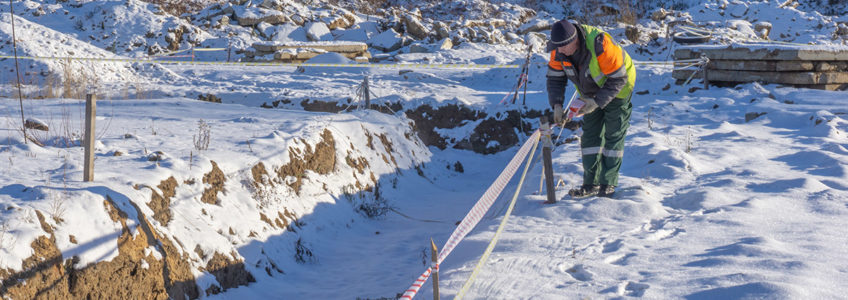
In the past we’ve discussed winter job site safety, but we’ve barely skimmed the surface of the risks to the project that a harsh winter brings. From frozen ground to compromised concrete, to brittle building materials, winter presents unique challenges to both residential and commercial builders. We face many of these challenges installing construction fence such as post-driven fence and silt fence. Let’s jump right into some of the more common challenges in winter construction.
Curing Concrete in the Winter
While concrete can be difficult to pour in the winter, it is actually possible to successfully pour and cure concrete. Curing involves a chemical reaction called hydration, which typically requires temperatures above 40 degrees Fahrenheit. If you’re building in Wisconsin, you know that during the winter, it’s a cause for celebration when temperatures rise above freezing, let alone sweatshirt weather. But ambient temperature north of 40 isn’t always required. Given the density of the components of most types of concrete, simply heating elements such as the aggregate can help raise the temperature enough to create the necessary reaction. The catch is, if you’re creating more than one batch you want to ensure that the pour temperature is consistent from one to the next, so you have consistent performance and predictable curing rates.
Another excellent aid is introducing a non-chloride chemical accelerant. While you may see greater curing performance out of an accelerant like calcium chloride, the chloride will corrode any steel reinforcement you’re using in the concrete, weakening the end product.
Digging with Frozen Ground
How many times have you showed up to a job site that needed a small amount of earth moved, whether it’s laying sewage lines/septic system, or trenching or pier holes for a foundation, and the ground is frozen like a block of ice. This is why we try to plan projects where excavation occurs before the freeze, but that’s not always possible. In that moment you’re scratching your head, wondering if the job needs to come to a standstill until Spring thaw. The good news is there are now products designed to help in these scenarios. One such product is large heated blankets designed to be left outdoors on the ground for several days in preparation of a dig. The average thaw takes roughly 24 hours per foot of permafrost, meaning you’re likely only hitting the pause button for 2 days.
Protect Your Building Materials
While your lumber may be safe from frigid temperatures, more delicate materials such as paints, epoxies, and some forms of weatherstrippings can become brittle if left unprotected against the elements. A loss of any of these materials could lead to hundreds if not thousands of dollars of waste. If possible, store sensitive building materials indoors, even if it’s an unfinished shell, as temperatures will likely stay above freezing versus the uncompromising cold of the outdoors. If you don’t have anywhere to store materials on-site, consider leaving the sensitive material in your shop and hauling it to the job site when you’re installing.
Winter construction in the Midwest can be difficult, however we’re here to help you get your job site set up. With products ranging from sandbags and silt fence to orange tree protection fence and temporary construction fences, let United Rent-A-Fence be your first call as you prepare for your next construction project.






